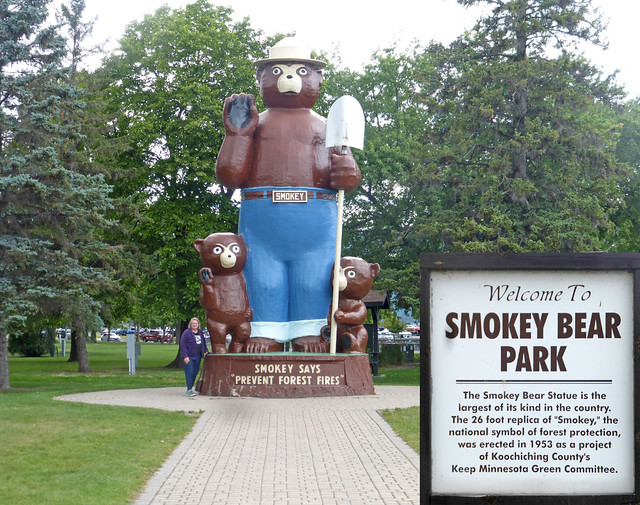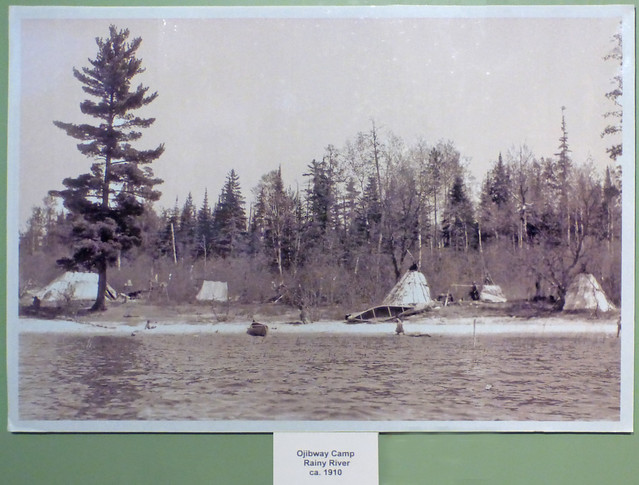Our second day on the trip with stops at Vermilion Falls and Voyaguer's National Park had taken us only about 55 miles farther north to International Falls and the Canadian border.

International Falls is probably most famous as "The Nation's Icebox" due to its frequent mention on winter weather reports when low temperatures dip into the minus 30s and below. With a population of fewer than 6,000 the town boasts a huge paper plant that has been turning pulpwood into paper for over a hundred years. The size of the plant can be gauged from this picture which shows the blue building from one edge of the photo to the other.

Currently owned by Packaging Corporation of America (PCA), the plant has a long production line that can turn out close to a thousand miles of paper per day. (That link goes to a ten minute video showing the paper production process.) One of the interesting sights as we entered town was the huge stack of pulpwood logs along the highway from Rainy Lake. It didn't appear that we could capture a good image, but the video at that link contains this image of the pulp logs:
Just across the street from the paper plant is a city park where Smokey the Bear stands watch near the town's dual museum: the Bronco Nagurski athletic museum and the Koochiching County historic museum. We just happened to arrive here on Smokey's 79th birthday and the 70th anniversary of the statue.

Bronco Nagurski was the town's most famous citizen. After great success on the gridiron at the University of Minnesota and with the Chicago Bears in the 1930s, Bronco took up a career as professional wrestler before returning to the Falls where he operated a service station for many years.


The Nagurski half of the museum includes a fifteen-minute video of his life and numerous souvenirs from the leather-helmet era of football.


Over in the Koochiching County half of the museum, there are the usual logging exhibits that you expect in a northern Minnesota local museum but also some excellent displays of the glacial geology of this area through the several ice ages that carved out the areas lakes and valleys - an excellent reminder of our ever-changing climate. This half of the museum also has an excellent history of the migration of the Ojibway people from the east coast to Minnesota and Wisconsin.


This photo of an Ojibway village was taken in 1910, just a year after my grandparents and family left their Minnesota homestead for Portland, Oregon.

One surprising exhibit revealed that the nearby town of Rainy was home to a minor "gold Rush" in 1893-4. No doubt obscured by the discovery of much richer gold fields in the Yukon at about the same time, this rush never turned Rainy into a boom town.

There are at least a pair of good restaurants in International Falls - we sampled the dinner fare at the Chocolate Moose and had an excellent breakfast at "The Library." It appears that a more lively evening scene is found along the river in adjacent Rainier, but we didn't discover it until late in the evening.

Before departing for our border crossing, we felt it was important to stop in at Border Bob's souvenir shop. You can purchase a wide variety of items here including some Walleye fillets to take home in case your Canadian fishing experience needs enhancement.


One popular item here is the famed Canadian Jam - it comes in a can and in a variety of flavors.


We passed by a large statue of "The Fisherman" at Howard's Cenex near the Chocolate Moose restaurant as we were preparing to leave town. I think he bears a strong resemblance to "Muffler Man" although he is only about two-thirds as tall.

The Rainy River is dammed at International Falls near the paper mill and the road across the dam takes you immediately to Canadian customs at the entry to Fort Frances (population almost 8,000).

Our Canadian customs officer was very pleasant to deal with and even gave some helpful advice for taking the most scenic route to Winnipeg via Kenora.






No comments:
Post a Comment